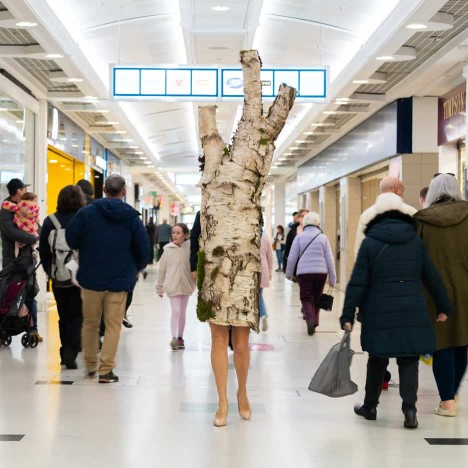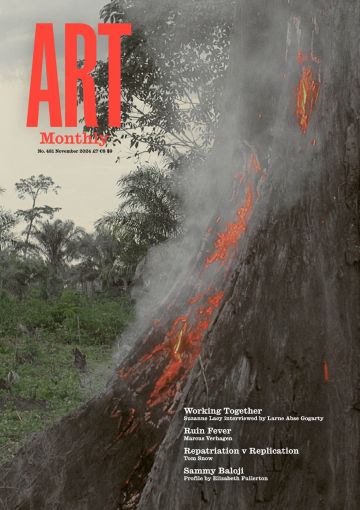Events
Middlesbrough Art Week
Tom Jeffreys reports on an exemplary critical art festival that supports communities of artists at the grassroots level

Olana Light, The Birch Tree Family, 2024
Numerous strategies of reuse are made visible across the 2024 edition of Middlesbrough Art Week: not only in pragmatic response to material conditions but also as an ethics of practice. Most of the programme takes place in retail spaces in the city centre, contemporary art rubbing along in more or less neighbourly fashion with chain clothing outlets, community bakeries and army surplus stores. In this context, the strongest works are those in which such strategies of reuse also inform a responsive politics of reclamation.
Initiated in 2017 as a weekender, Middlesbrough Art Week (MAW) is delivered by The Auxiliary, an organisation that manages artist studios as well as exhibition and workshop spaces out of a large former warehouse by the train station. Most of the team are artists, and the project’s ethos is underpinned by this situated understanding of the organisational support that artists need. The heart of MAW is the North East Open Call (NEOC) group exhibition. Its two-step application process is exemplary: in round one, artists can apply with as little as an Instagram link; in round two, a jury selects a shortlist of 20, who are paid to develop a proposal. The eight artists selected for the 2024 exhibition each receive a fee of £500. Across town, participants in the New Graduate Award exhibition receive the same participation fee. It’s a small gesture but a significant one. In conversation at the opening, NEOC curator Penelope Payne cites the importance of Industria’s 2023 ‘Structurally F–cked’ report into precarious working conditions for artists (see Susan Jones’s ‘Artists’ Exploitation’ in AM468). ‘This festival is leading by example,’ she says.
A National Portfolio organisation since 2023, The Auxiliary building is currently undergoing significant repairs ahead of reopening in 2025. It is partly this closure that has necessitated MAW’s use of so many alternative spaces. It means that shoppers hunting fast fashion can also discuss mass species loss via Amy Dover’s You can’t bury what is lost, when the world goes small, 2024, a characteristically painstaking drawing gradually erased by participating passers-by. Those having their mobile phone repaired can relax on a deck chair and watch Kyriaki Goni’s Not Allowed for Algorithmic Audiences, 2021, in which a personified algorithm explains the systemic biases and catastrophic climatic effects of artificial intelligence.
The NEOC exhibition is a curatorial triumph, the space’s exposed infrastructure and leaky ceiling speaking with, but never over, the works themselves. Mark Bletcher’s paintings – lush with queer mythologies – feel all the dreamier against a breeze-block backdrop. Christine Walker’s not-quite-functional ceramic sculptures, clustered together like a post-industrial landscape, meld a rapturous array of surface textures – from cracked and flaking to smooth like melted plastic or spilled petrol. One teeters precariously on the edge of a grey-painted plinth, and it’s hard not to see such vulnerability as metaphorical. On opening night, they glitter under artificial light.
Across the exhibition, old things find new meanings in several works. Advocating slowed-down practices of making, Eileen White’s black-and-white photographs of the composting area of Chelsea Physic Garden are developed using less toxic chemicals made from food waste, and printed onto left-over packaging. Here, they are hung from the ceiling, making visible the obverse packaging labels (tea bags, pasta, chocolate biscuits, photographic paper) as well as previous methods of display. Nearby stands Chris Thompson’s The Vessel, 2023–24, a gargantuan ship-bar display unit made from reclaimed parquet flooring and cupboard doors. Plentiful drawers hold unexpected objects of no obvious current value (fake gold eagles, the sleeves from a leather jacket) in an exuberant critique of institutional display aesthetics (and the value systems that underpin them).
Migration is a key concern. In Henna Asikainen’s Wing Cradle, 2023, a sculptural assemblage hangs from the ceiling. A structure made with thousands of white feathers (in reference to the migration of birds in Finnish mythology) is held or constrained by harnesses from a horse made to serve in a human war. Around this totemic piece, visitors can sit and listen to the artist’s friend, Zainah Adnan, discuss her lived experience of migration and the fear, confusion and heart-breaking frustration at dealing with the UK’s grossly unjust asylum system.
Away from NEOC, Alia Gargum’s ‘This was a Mosque / هذا كان مسجد’ is an intense, beautiful, multi-layered solo exhibition that evokes half-details of vivid memories and lost places. Exploring the role of heritage for those who experience forced migration, Gargum’s work navigates diasporic identity through and against institutional architectures of power. The exhibition was recently shown at the Hatton Gallery in Newcastle, where cascades of lush green fabric were wrapped around the Edwardian-era building’s rather grandiose internal columns. Here, in an empty retail unit next to a Warhammer store, a poetic audio piece draws you into the exhibition. Inside, there is metal coated in verdigris and traces of rust visible across the green; the experience is at once materially rich and comparatively minimal. Most of the materials have been reused – wood from church pews, metal from previous sculptures. Gargum tells me that the migratory experience informs her approach: if the world can be turned against you at any moment, you’ll always be ready to pack up and leave. The title is a reference to Israel’s destruction of mosques in Gaza.
Relatedly, the work of UPROOT collective also speaks to experiences of belonging and precarity. The group have worked with schools, community leaders and migrant support networks to plant small-scale meadows across Middlesbrough. For MAW, these have been relocated inside Pineapple Black, an art gallery in a former New Look store. Given that Middlesbrough is one area where profiteering companies contracted by the Home Office prefer to ‘disperse’ refugees, the project aims to offer a small contribution to the possibility of making a home, while highlighting the scandalous difficulties of doing so in the face of the UK’s hostile environment policies.
MAW took place less than two months after racist and Islamophobic rioting across the UK. In A Town of Immigrants, a pamphlet published in 2019 by Middlesbrough Institute of Modern Art (MIMA), Tosh Warwick charts a local history of divisions stoked from above: from the 1840 Middlesbrough Dock riot to the Canon Street ‘race riots’ of 1961. ‘Immigrant communities’, Warwick argues, ‘are often singled out for hostility and used as scapegoats at times of national social and economic instability and during international conflict.’
In From Kashmir to Roseberry Topping, from the same pamphlet series, Marsha Garratt writes: ‘Migration is never one way. But for too long the story of migration has been told from the perspective of the oppressor.’ It is with perfect irony that, for MAW, Karrabing Film Collective’s video installation, Night Fishing with Ancestors, 2023, narrating the colonisation of Australia as both a historic and continuing process, is presented in a former gambling shop on Captain Cook Square. The Auxiliary’s directors acknowledge that the cultural community’s response to racism needs to be stronger and more visible. In dextrously making space for storytelling by the oppressed, Middlesbrough Art Week is a vital contribution.
Middlesbrough Art Week took place from 26 September to 5 October 2024.
Tom Jeffreys is a writer based in Edinburgh.
First published in Art Monthly 481: November 2024.











